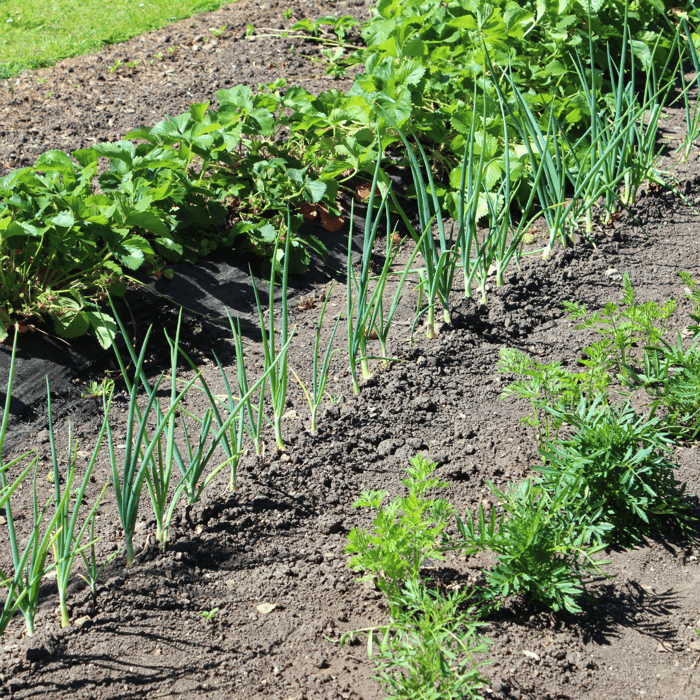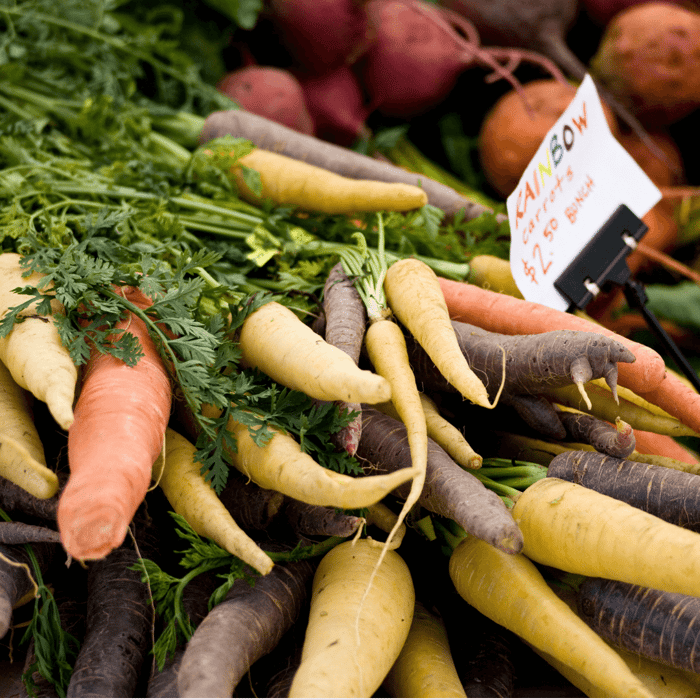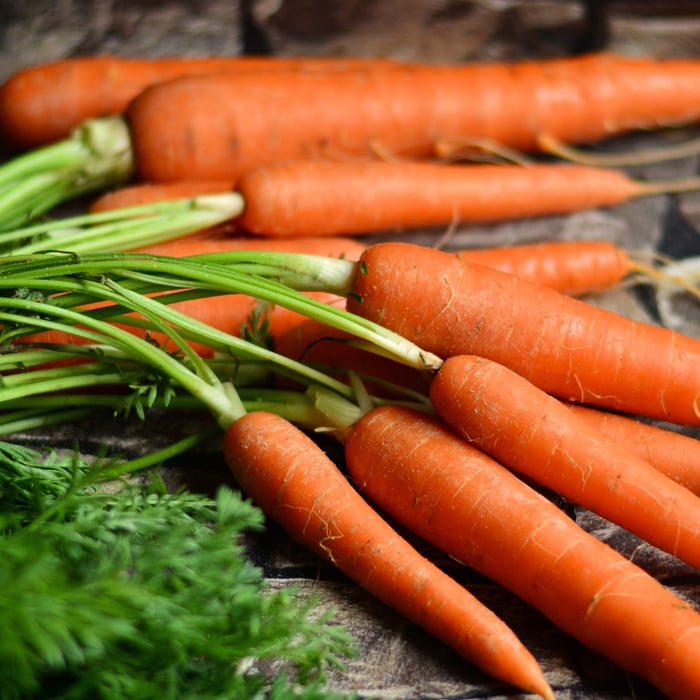Growing your own vegetables is a rewarding experience that provides fresh and nutritious food for you and your family. However, not everyone can grow vegetables in a large garden or outdoor space. This is where container gardening comes in as a solution. Learning how to grow carrots in containers will be a real space-saver.
Carrots are one of the easiest vegetables to grow in containers, and doing so has many benefits. One of the main benefits of growing carrots in containers is space-saving.
You don't need much outdoor space to grow carrots in containers. Even if you live in an apartment or have a small balcony, you can still enjoy homegrown carrots.
Container gardening also allows you to control the soil conditions better than traditional gardening methods, leading to healthier plants and better yields. Another benefit of growing carrots in containers is the ease of maintenance.
Unlike traditional gardening methods, container gardening requires less weeding and bending over. Container-grown carrots are also less susceptible to pests and diseases than those grown directly in the ground.
When it comes down to it, growing your own food just feels good - both physically and mentally. You'll get exercise from tending your garden and be rewarded with fresh produce you can be proud of.
In this ultimate guide, we'll go over everything you need to know about growing carrots in containers - from choosing the right container size and shape, preparing the soil, planting seeds, maintenance tips for healthy plants, troubleshooting common problems that may arise along the way, up until harvesting time. So let's dig into this guide on how to grow carrots in containers!
Choosing the Right Container
The Ideal Size and Shape of Containers for Growing Carrots
When it comes to growing carrots in containers, size and shape matter. The ideal container for growing carrots is 12 inches deep and 12 inches wide. This container size will allow carrot roots to grow deep and straight without becoming too crowded.
In terms of shape, long and rectangular containers are great options for growing carrots. These shapes allow you to plant multiple rows of carrot seeds, maximizing the space used in the container.
Carrot Seeds For Planting | 5 Variety Pack
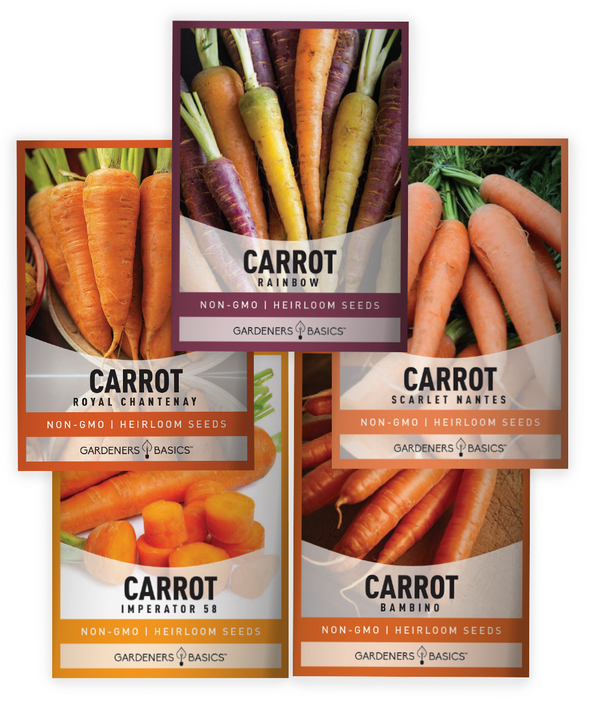
$9.95
Grow Your Own Carrots: 5 Carrot Seeds Variety Pack – Heirloom, Non-GMO, Open-Pollinated Introducing our 5 Carrot Seeds Variety Pack – a premium collection of heirloom carrot seeds designed for gardeners who want to grow fresh, vibrant, nutrient-packed carrots right… read more
The Importance of Drainage Holes
Proper drainage is crucial when it comes to growing carrots in containers. Excess water can accumulate without adequate drainage at the bottom of the container, leading to root rot or other issues that can harm your plants.
Ensure your container has drainage holes at the bottom that are large enough for water to escape easily. You can add more holes or use a drill to make them yourself if necessary.
Proper Soil Depth
Another important factor to consider when choosing a container for growing carrots is soil depth. As mentioned earlier, a depth of at least 12 inches is necessary for carrot roots to grow straight and deep. It's also important not to fill your container all the way up with soil from the start.
Instead, start with a layer of soil about 2-3 inches deep and add more as your carrot plants grow taller. Additionally, ensure you're using quality potting mix specifically designed for vegetable gardening rather than garden soil or topsoil, which may not be well-draining enough or contain pests or diseases.
Adequate Space Between Carrots
Carrots require space between each other, so they have room to grow their taproots without competing with neighboring plants. To give your carrots enough room to grow, space them at least 1 inch apart and no more than 3 inches apart. If planting multiple rows of carrots in a single container, ensure at least 2-3 inches of space between each row.
Choosing the Right Material for Containers
Several options are available when choosing the right material for containers to grow carrots. Clay or terra cotta pots are excellent choices since they are porous and allow air and water to pass through them easily. Plastic containers are also a good option as they retain moisture well, but make sure they have adequate drainage holes.
Avoid using metal containers as they heat up quickly in the sun or become too cold during colder months. Wooden containers can also be risky since they can rot over time if not treated with the proper preservatives.
Preparing the Soil
Carrots are root vegetables that require loose, well-draining soil to grow properly. The ideal soil composition for growing carrots is sandy or loamy, with a neutral pH between 6 and 7.5.
This soil structure allows for proper root development, which is essential for healthy carrot growth. Before planting carrot seeds in containers, properly preparing the soil is essential.
Start by filling your container with quality potting mix specifically formulated for vegetables, or add equal parts of compost, peat moss, and vermiculite to the regular potting mix. This will ensure that your carrots receive all the necessary nutrients to grow.
In addition to providing good drainage and aeration, carrots also require adequate moisture retention in the soil. Adding organic matter like compost helps improve the soil's water retention capacity while providing essential nutrients that promote plant growth.
To prepare your container's soil for carrot plants, use any organic fertilizer, such as worm castings and fish emulsion, which can help improve the overall health of your plants. When adding fertilizer or compost to your container, do not fill it too high with these materials. Doing so can lead to poor drainage by compacting them, making it difficult for roots to penetrate deep into the ground causing stunted growth of crops like carrots.
Adequately prepared soil will make a big difference in producing healthy carrot plants in containers without disease problems or low-quality yields at harvest time. Following these steps ensures that your container-grown carrots will thrive and produce a bountiful harvest.
Vegetable Seed Vault Kit | 35 Variety Pack

$29.95
$49.95
Ultimate Survival Seed Vault: 16,000+ Non-GMO Heirloom Vegetable Seeds for Emergency Preparedness Introducing the Seed Vault Kit, your all-in-one solution for emergency preparedness and sustainable gardening. This premium seed kit contains over 16,000 non-GMO, Heirloom, Non-Hybrid, and Open Pollinated seeds,… read more
Planting Seeds
Proper Planting Procedures
Planting carrot seeds in containers is similar to planting them in the ground. However, there are a few things to note to ensure that your seeds will have the best chance of growing into healthy and productive plants. First, choosing the right type of carrot seed for container gardening is essential.
Shorter varieties like "Little Finger" or "Thumbelina" are ideal because they do not require as much depth as longer varieties. When planting carrot seeds, it's crucial to make sure that you sow them at the proper depth.
The general rule is to plant them about a quarter-inch deep, but this can vary depending on the variety of carrots you're growing. Check the seed packet for specific instructions on planting depth and spacing.
Once you've determined how deep to plant the seeds, press them into the soil with your finger or a small tool like a dibber. Make sure that each seed is spaced about an inch apart from one another to avoid overcrowding. Often people cast carrot seeds across the soil, mixed with a small amount of wet sand to help cast the tiny seeds.
Watering Your Seeds
After sowing your carrot seeds in containers, it's essential to water them properly and regularly. Carrot seeds need consistent moisture throughout their germination period, typically around 14 days. Use a watering can with a fine spray or mist nozzle to water your seeds correctly.
This will ensure you don't wash away any of the soil around your newly planted seeds. Be careful not to overwater since this can cause the soil to become too saturated and rot.
It's also important not to let your container dry out completely during this time frame since this can prevent germination altogether. Check on your container daily and monitor moisture levels so you can adjust watering frequency accordingly.
Thinning Your Seedlings
After your carrot seeds have germinated and started to grow, you may notice that they are growing too close together. This can lead to overcrowding and stunted growth, so thinning out your seedlings is essential. Use scissors or small garden shears to snip off the tops of extra seedlings at the soil line to thin out your seedlings.
Leave one plant per inch of space in the container. This will allow each plant enough space for its roots to grow and develop into full-sized carrots.
Protecting Your Seeds
Once your herloom seeds are planted, you'll want to protect them from birds or other animals tempted by their tasty greens. One way to do this is by covering the container with bird netting or a wire mesh layer until the seeds have sprouted.
Another method is creating a "cage" around each seedling using bamboo stakes and chicken wire. This will give each plant some protection while still allowing for airflow and sunlight.
Properly planting carrot seeds in pots takes care and attention, but with a little preparation, you'll be rewarded with healthy plants and delicious carrots in no time. Always choose the right carrot seed for container gardening, sow at the proper depth, water regularly but not too much, thin out your seedlings when necessary, and protect them until they're strong enough to fend for themselves.
Maintenance
Growing carrots in containers requires proper maintenance to ensure healthy growth and high yields. This section will cover two essential aspects of maintaining container-grown carrots: watering and fertilizing.
Proper Watering Techniques for Container-Grown Carrots
Proper watering is crucial for the success of any plant, especially when it comes to container gardening. Carrots are no exception, requiring consistent moisture levels to develop their sweet flavor and tender texture. You first need to remember that carrots have shallow roots, so you should avoid overwatering them.
Too much water can cause the roots to rot, leading to stunted growth or even death. On the other hand, insufficient water can result in hard, woody roots.
To maintain optimal moisture levels in your carrot containers, you should water them regularly but not excessively. The watering frequency will depend on various factors, such as the size of your container, the temperature and humidity of your environment, and the stage of plant growth.
Generally, you should aim to keep the soil moist but not soaked. You can check if your soil needs watering by sticking your finger to your second knuckle; if it feels dry at that depth, it's time to water.
Another helpful tip is to use a watering can with a fine rose attachment or a drip irrigation system instead of a hose or sprinkler. These methods allow you to control the amount and location of water more precisely without disturbing the soil surface or causing runoff.
Scarlet Nantes Carrot Seeds
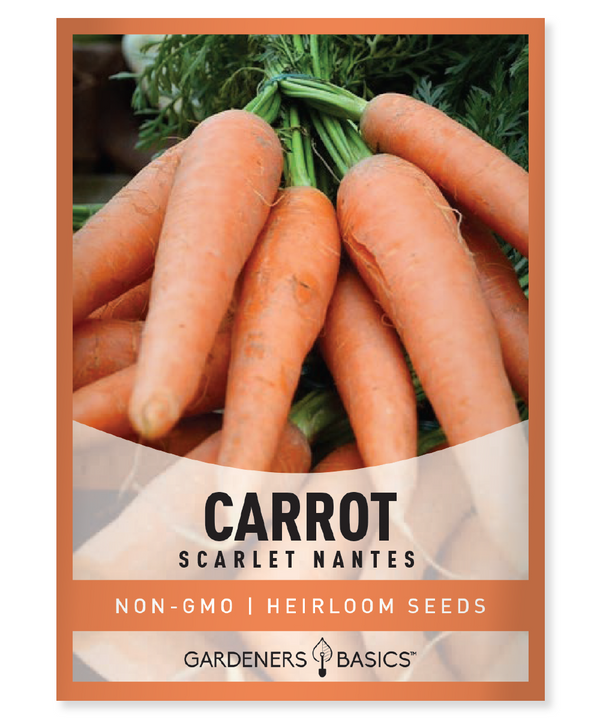
$2.49
Scarlet Nantes Carrot Seeds - Heirloom, Non-GMO, Open-Pollinated, Non-Hybrid | Sweet & Tender Carrots for Home Gardens Grow deliciously sweet and tender carrots with our Scarlet Nantes Carrot Seeds, perfect for home gardens, raised beds, and small-scale farming. These heirloom,… read more
How To Fertilize And Weed Pot-Grown Carrots
Fertilizing and weeding are essential for maintaining healthy carrot plants that produce abundant harvests. This section discusses how to do both properly in container gardens. Fertilizing helps provide essential nutrients that plants need for optimal growth and productivity.
When it comes to carrots, they require a balanced fertilizer with equal amounts of nitrogen, phosphorus, and potassium. You can use either organic or synthetic fertilizers, depending on your preference.
Organic options include compost, well-rotted manure, bone meal, or fish emulsion. These provide gentle, slow-release nutrients on plants and improve soil structure and fertility in the long run.
Synthetic fertilizers come in various forms, such as liquid concentrates or granules that dissolve in water. They provide fast-acting nutrients readily available to plants but can burn them if overused.
To apply fertilizer to your carrot containers correctly, follow the instructions on the package carefully and avoid applying too much at once. A general recommendation is to fertilize every 4-6 weeks during the growing season.
Weeding is another crucial task for maintaining healthy carrots because it prevents competition for nutrients and space from unwanted plants such as grasses or weeds. Weeds can also harbor pests and diseases that can damage your crop.
To weed container-grown carrots properly, use a small hoe or a hand trowel to remove weeds carefully without disturbing the soil too much. Remove all weeds' roots so they won't regrow quickly.
Proper watering techniques and regular fertilizing and weeding are essential for maintaining healthy container-grown carrots that produce high-quality roots with excellent flavor and texture. By following these tips, you'll be able to enjoy a bountiful harvest of fresh homegrown carrots throughout the growing season!
Harvesting Carrots Grown in Containers
When to harvest carrots grown in containers
Harvesting carrots at the right time ensures their best flavor and texture. Generally, it takes around 60-80 days for carrots to mature, depending on the variety and growing conditions.
To check if your container-grown carrots are ready for harvest, gently push aside the soil near the top of a carrot root and look for its size and color. Carrots are usually ready when they reach about 1 inch in diameter, and their color is deep orange or red.
You can also use a fork or a small trowel to lift one carrot out of the container and check its size. If it's not the desired size, leave them in the container for about another week or two before checking again.
How to properly pull up carrot roots from containers without damaging them
After determining that your container-grown carrots are ready for harvest, take care when pulling them up so as not to damage the root. First, carefully loosen the soil around each carrot using a spade or fork.
Hold onto the greens (or what's left of them) with one hand while pulling on the leaves with another hand. This will help you loosen and lift out each carrot from its hole without breaking it off at ground level.
If you find some of your carrots difficult to extract, gently rock them back and forth until they release from the soil rather than pulling too hard, which may break them apart. Once harvested, remove any loose dirt or debris from your newly dug-up crop before storing it for storage or use in meals.
A few harvesting tips
- Harvest your carrots early morning hours when they're crisper.
- If you have matured bunches of carrots with leaves still attached, cut off the top stubs nearly 1 inch above the top of the carrot before storing them to help them last longer.
- You can also tug your carrots to check if they're ready. If they don't come out easily, wait a few more days before checking again.
- Be sure not to pull or yank up carrots from the soil, as this could damage and breakage to the carrot.
- After harvesting carrots cut off greens/stems from the roots. Leaving greens attached to a carrot dehydrates it quickly, making it limp.
Troubleshooting Common Problems
The Pests That Can Wreak Havoc on Your Carrots
Carrots are susceptible to various pests that can cause significant damage to plants and reduce yields. One of the most common pests is the carrot fly, which lays eggs near the base of young carrot plants.
The resulting larvae tunnel into the roots, causing them to become misshapen and inedible. To prevent this pest from infesting your container-grown carrots, cover them with horticultural fleece or fine mesh netting.
Another common pest is the aphid, which feeds on plant sap and excretes a sticky substance called honeydew that can attract other pests and cause fungal growth on leaves. Introduce natural predators such as ladybugs or lacewings into your garden to prevent an aphid infestation.
You can also spray affected plants with water and dish soap to suffocate the insects. Carrot rust flies are known for causing significant damage to carrot crops.
They lay their eggs at the base of young plants, leading to galls that distort root development. To prevent these pests from taking hold in your containers, try covering the soil with an insect-repelling mulch like pine needles or straw.
Recognizing Signs of Disease
Carrots are also susceptible to diseases that can cause stunted growth, wilting foliage, and other symptoms that reduce yield quality. One common disease is root rot, caused by overwatering or poor container drainage. Symptoms include yellowing foliage and mushy roots that smell foul when pulled up from the soil.
Another disease affecting carrots is powdery mildew caused by fungal spores carried through air currents or contaminated gardening equipment. Symptoms include white powdery patches on leaves or stems that eventually turn brown and die.
It is best to take a preventative approach to treat diseases in your container-grown carrots. Practice good soil hygiene by rotating crops and adding organic matter.
Avoid overwatering or watering from above, as this can create an environment conducive to fungal growth. Always clean your gardening tools and equipment before use.
Bambino Carrot Seeds
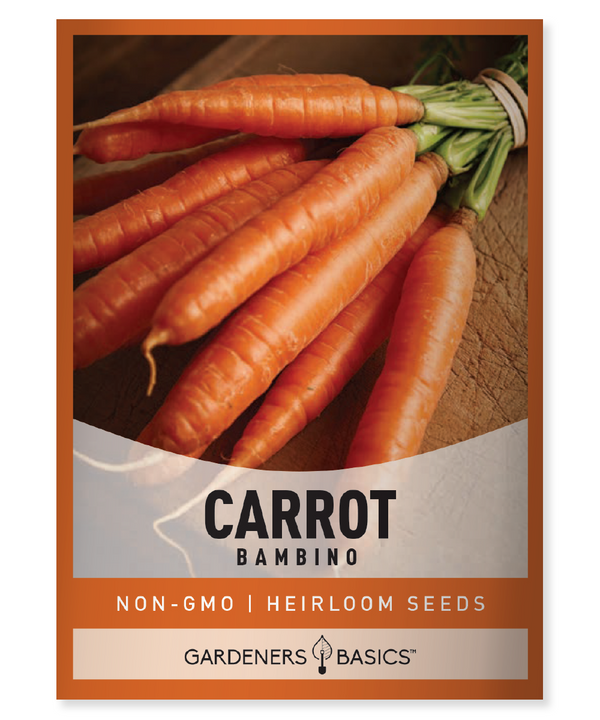
$2.49
Bambino Carrot Seeds - Heirloom, Non-GMO, Non-Hybrid, Open-Pollinated Carrots for Your Garden Grow sweet, tender, and crisp baby carrots with our Bambino Carrot Seeds, perfect for home gardens and urban spaces. These heirloom, non-GMO, non-hybrid, open-pollinated carrot seeds produce compact… read more
Preventing Common Problems
The best way to prevent common problems from affecting your container-grown carrots is to start with healthy plants and maintain good growing conditions throughout their lifecycle. Plant seeds in well-draining containers with fresh potting mix enriched with compost or fertilizer.
Water regularly, but avoid overwatering the plants, which can lead to rot or fungal disease. Provide adequate sunlight, as carrots need at least six hours of direct sunlight daily for optimal growth.
Additionally, consider companion planting to prevent pests from taking hold in your garden. Plants like garlic, onions, and marigolds can help repel carrot flies and unwanted visitors.
Intervening When Problems Occur
When problems occur with your container-grown carrots, it is important to intervene quickly before they get out of hand. Remove affected leaves or stems promptly and dispose of them from the garden bed. For pest infestations, try using natural methods like introducing predators or spraying affected plants with soap.
For diseases like powdery mildew or root rot caused by overwatering, adjust growing conditions accordingly by reducing the watering frequency or providing better drainage. In some cases where problems persist despite intervention measures being taken early on, it may be necessary to remove affected plants entirely to protect the health of surrounding crop yield quality overall.
Conclusion
After reading this article, you know how to grow carrots in containers. We discussed the benefits of growing carrots in containers, such as space-saving and ease of maintenance. We also reviewed how to choose a suitable container, prepare the soil, plant seeds, maintain healthy growth, and harvest carrots.
When choosing a container, it's essential to consider the size and shape that will allow your carrot roots to grow deep without getting cramped. Proper drainage holes are necessary for avoiding waterlogging, which can cause root rot.
The preparation of the soil is crucial in ensuring optimum growth. You should use compost or fertilizer to enrich your soil before planting your seeds.
Consider using a good-quality potting mix specifically designed for growing vegetables. Maintenance is vital when it comes to growing carrots in containers.
Ensure you water them consistently and fertilize them regularly with an organic fertilizer. Keep an eye out for any pests or diseases that might affect the growth of your plants.
Harvesting should be done when the green tops start poking out from the soil, indicating it's time for harvesting. Carefully pull each carrot from its container by holding onto its top leaves and gently lifting it straight out from its soil bed.
Why Growing Carrots In Containers Is A Great Option For Gardeners
Growing carrots in containers have numerous advantages over traditional gardening methods. Firstly, it provides a space-saving option as you can grow multiple plants within limited areas such as balconies and patios. Secondly, it enables people living in apartments or urban areas without yards to enjoy fresh homegrown produce without access to garden plots.
The convenience factor is another advantage of container gardening; it's ideal for those who have mobility issues or find traditional gardening too labor-intensive. Additionally, growing carrots in containers is less prone to soil-borne diseases and pests, which can be difficult to manage in outdoor gardens.
Growing carrots in pots is a great way to involve children in gardening activities and teach them about sustainability and self-sufficiency. It's always a joy for kids to watch their plants grow and flourish as they take care of them.
Growing carrots in containers is an excellent option for gardeners who want fresh produce without the hassle of traditional gardening methods. You can enjoy healthy, delicious homegrown carrots all year round using the abovementioned techniques.
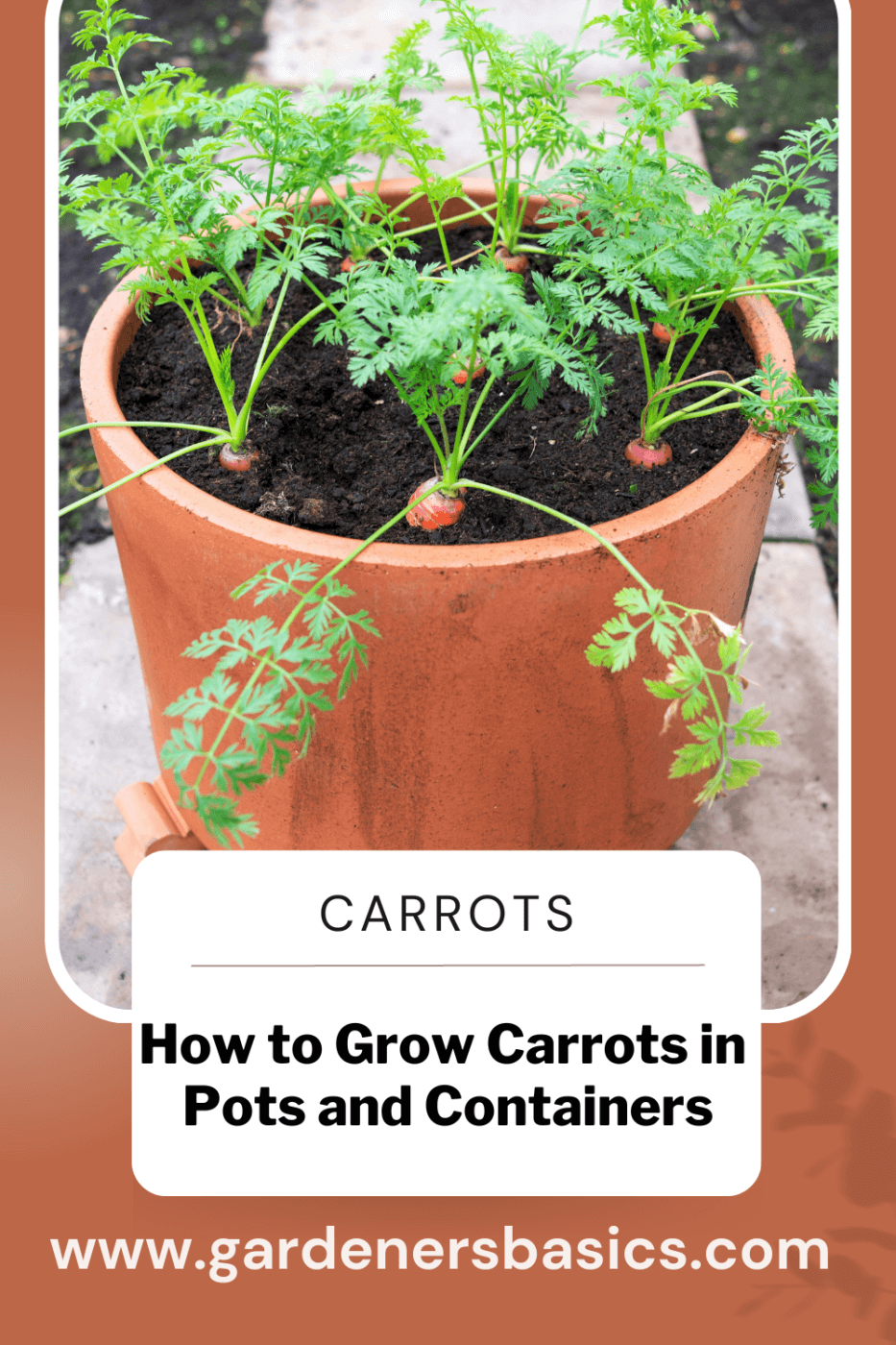 FAQ: How to Grow Carrots in Containers
FAQ: How to Grow Carrots in Containers
1. Q: What is the optimal container size for growing carrots?
A: Carrots need a deep container to accommodate their growth. A container depth of at least 12 inches is typically recommended.
2. Q: Which variety of carrots is best suited for container gardening?
A: Shorter varieties such as 'Little Finger,' 'Parisian,' and 'Nantes' are typically the best choices for container gardening.
3. Q: How much sunlight does container-grown carrots require?
A: Carrots, like most vegetables, need lots of sunlight. Ideally, they should get 6 to 8 hours of full sun daily.
4. Q: What soil is best for growing carrots in containers?
A: A light, well-draining soil mix, free of rocks and heavy clay, is ideal for growing carrots. It should also be rich in organic matter.
5. Q: How often should I water the carrot plants?
A: You should keep the soil moist but not soggy. Overwatering can cause the carrots to split, while underwatering can lead to tough, fibrous roots.
6. Q: When is the best time to plant carrot seeds?
A: Carrot seeds can be planted in the early spring, a few weeks before the last expected frost. They can also be planted in late summer for a fall harvest.
7. Q: How long does it take for carrots to grow in containers?
A: Depending on the variety, carrots typically take between 50 and 75 days to mature from the time of planting
8. Q: What common pests should I watch out for when growing container carrots?
A: Carrot flies, aphids, and root-knot nematodes are common pests affecting carrot plants. Using netting or plant collars can help protect your plants from these pests.
9. Q: How do I know when my container carrots are ready to harvest?
A: You can typically tell when carrots are ready to harvest by looking at the size of the carrot shoulders at the soil surface. Generally, most carrots are ready to harvest when ½ to ¾ inches in diameter.





